Comprehensive Case Studies on Business and Corporation Law
VerifiedAdded on 2023/01/13
|10
|2869
|74
Case Study
AI Summary
This document presents a series of case studies focusing on key aspects of business and corporation law. The first case examines the liability of a financial advisor for misleading conduct, analyzing the advisor's breach of duty of care and potential for apportionment of liability under the Corporations Act 2001. The second case explores the negligence of a public authority, specifically a city council, in providing inaccurate information, leading to financial losses for an individual. This section analyzes the council's potential liability under the Human Rights Act 1998 and relevant case law regarding negligence. The third case study delves into contract law, evaluating the validity of agreements, breach of contract scenarios, and the liability of parties involved in property transactions and loan guarantees. The analysis covers issues of offer and acceptance, implied contracts, and the obligations of guarantors. The document provides detailed legal analysis and conclusions for each case, drawing upon relevant legislation and case precedents.
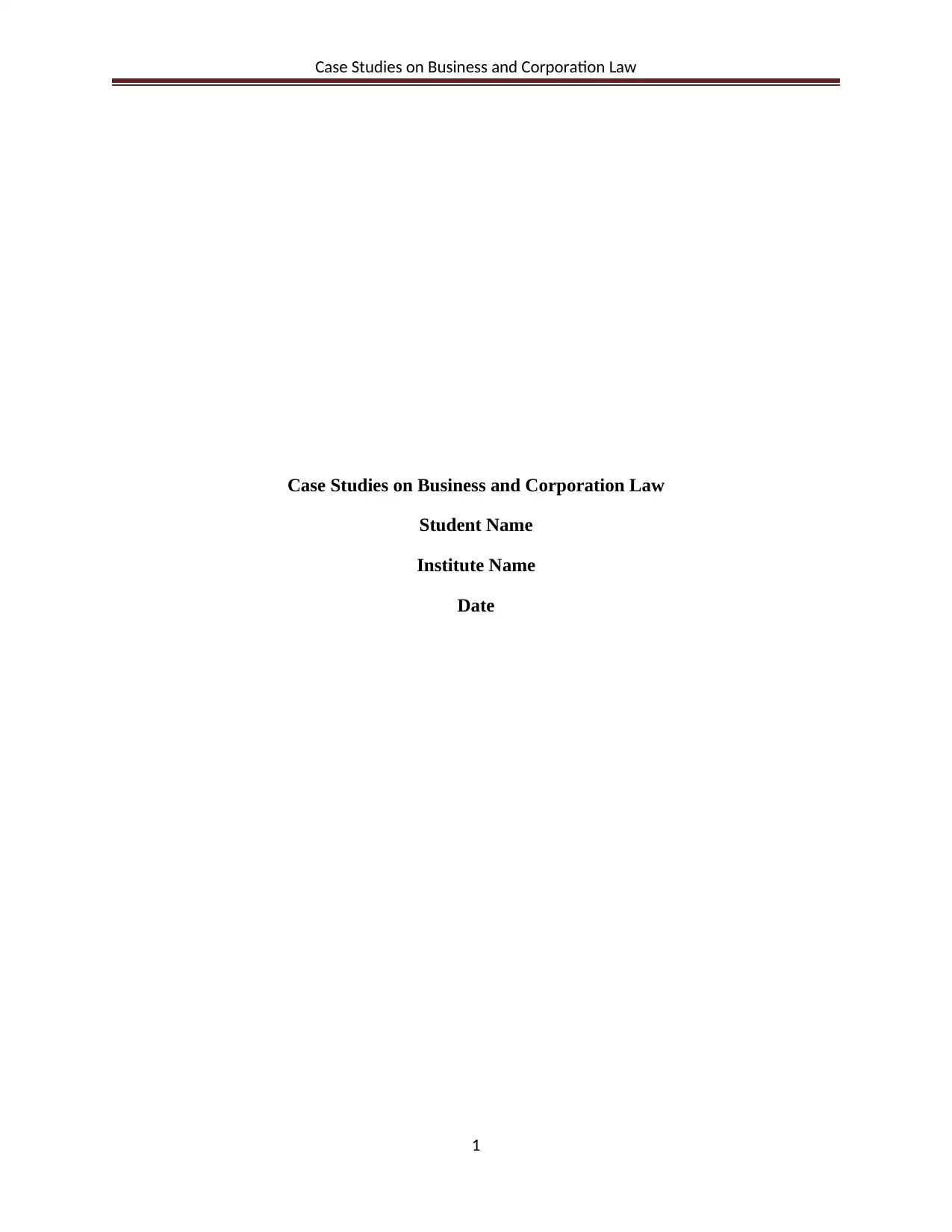
Case Studies on Business and Corporation Law
Case Studies on Business and Corporation Law
Student Name
Institute Name
Date
1
Case Studies on Business and Corporation Law
Student Name
Institute Name
Date
1
Paraphrase This Document
Need a fresh take? Get an instant paraphrase of this document with our AI Paraphraser
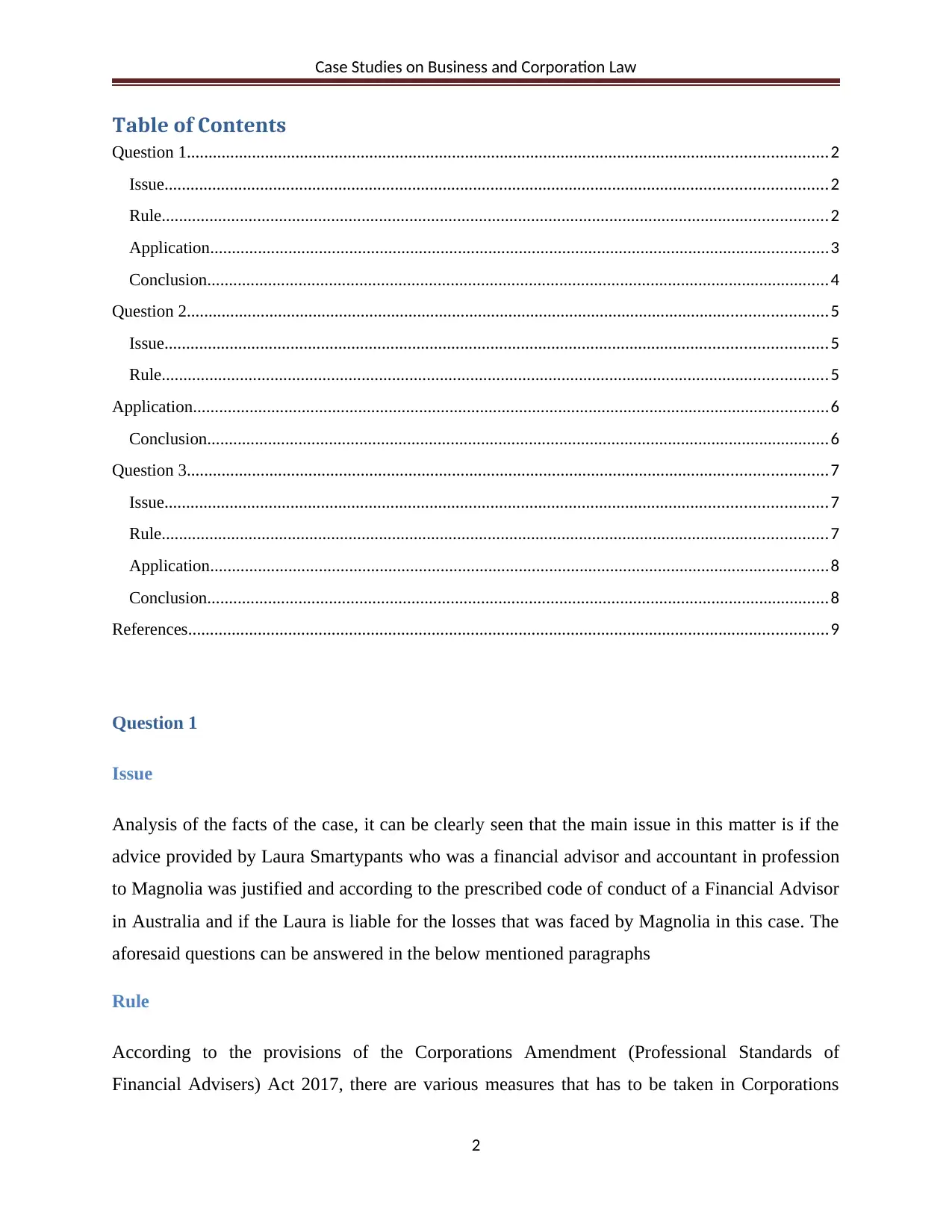
Case Studies on Business and Corporation Law
Table of Contents
Question 1...................................................................................................................................................2
Issue........................................................................................................................................................2
Rule.........................................................................................................................................................2
Application..............................................................................................................................................3
Conclusion...............................................................................................................................................4
Question 2...................................................................................................................................................5
Issue........................................................................................................................................................5
Rule.........................................................................................................................................................5
Application..................................................................................................................................................6
Conclusion...............................................................................................................................................6
Question 3...................................................................................................................................................7
Issue........................................................................................................................................................7
Rule.........................................................................................................................................................7
Application..............................................................................................................................................8
Conclusion...............................................................................................................................................8
References...................................................................................................................................................9
Question 1
Issue
Analysis of the facts of the case, it can be clearly seen that the main issue in this matter is if the
advice provided by Laura Smartypants who was a financial advisor and accountant in profession
to Magnolia was justified and according to the prescribed code of conduct of a Financial Advisor
in Australia and if the Laura is liable for the losses that was faced by Magnolia in this case. The
aforesaid questions can be answered in the below mentioned paragraphs
Rule
According to the provisions of the Corporations Amendment (Professional Standards of
Financial Advisers) Act 2017, there are various measures that has to be taken in Corporations
2
Table of Contents
Question 1...................................................................................................................................................2
Issue........................................................................................................................................................2
Rule.........................................................................................................................................................2
Application..............................................................................................................................................3
Conclusion...............................................................................................................................................4
Question 2...................................................................................................................................................5
Issue........................................................................................................................................................5
Rule.........................................................................................................................................................5
Application..................................................................................................................................................6
Conclusion...............................................................................................................................................6
Question 3...................................................................................................................................................7
Issue........................................................................................................................................................7
Rule.........................................................................................................................................................7
Application..............................................................................................................................................8
Conclusion...............................................................................................................................................8
References...................................................................................................................................................9
Question 1
Issue
Analysis of the facts of the case, it can be clearly seen that the main issue in this matter is if the
advice provided by Laura Smartypants who was a financial advisor and accountant in profession
to Magnolia was justified and according to the prescribed code of conduct of a Financial Advisor
in Australia and if the Laura is liable for the losses that was faced by Magnolia in this case. The
aforesaid questions can be answered in the below mentioned paragraphs
Rule
According to the provisions of the Corporations Amendment (Professional Standards of
Financial Advisers) Act 2017, there are various measures that has to be taken in Corporations
2
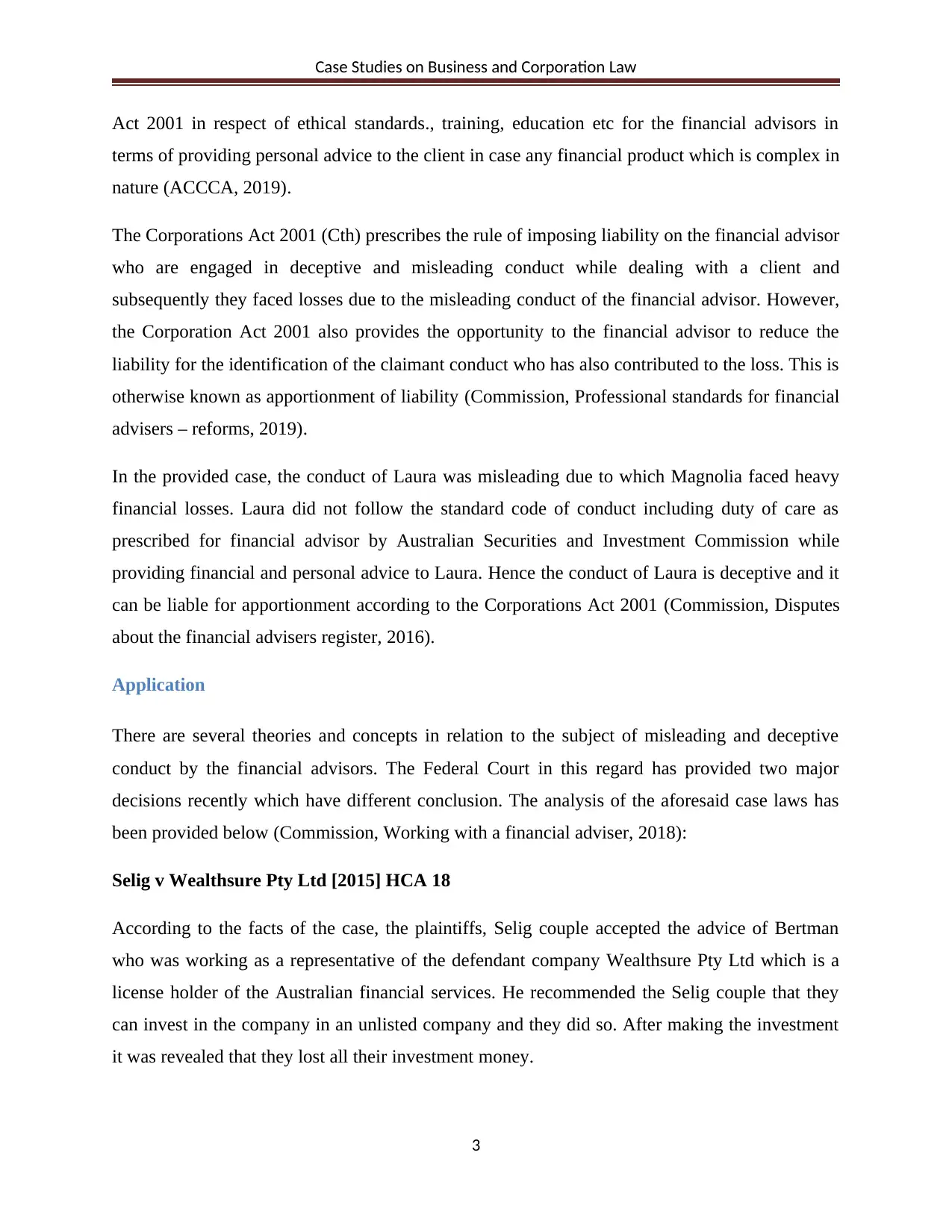
Case Studies on Business and Corporation Law
Act 2001 in respect of ethical standards., training, education etc for the financial advisors in
terms of providing personal advice to the client in case any financial product which is complex in
nature (ACCCA, 2019).
The Corporations Act 2001 (Cth) prescribes the rule of imposing liability on the financial advisor
who are engaged in deceptive and misleading conduct while dealing with a client and
subsequently they faced losses due to the misleading conduct of the financial advisor. However,
the Corporation Act 2001 also provides the opportunity to the financial advisor to reduce the
liability for the identification of the claimant conduct who has also contributed to the loss. This is
otherwise known as apportionment of liability (Commission, Professional standards for financial
advisers – reforms, 2019).
In the provided case, the conduct of Laura was misleading due to which Magnolia faced heavy
financial losses. Laura did not follow the standard code of conduct including duty of care as
prescribed for financial advisor by Australian Securities and Investment Commission while
providing financial and personal advice to Laura. Hence the conduct of Laura is deceptive and it
can be liable for apportionment according to the Corporations Act 2001 (Commission, Disputes
about the financial advisers register, 2016).
Application
There are several theories and concepts in relation to the subject of misleading and deceptive
conduct by the financial advisors. The Federal Court in this regard has provided two major
decisions recently which have different conclusion. The analysis of the aforesaid case laws has
been provided below (Commission, Working with a financial adviser, 2018):
Selig v Wealthsure Pty Ltd [2015] HCA 18
According to the facts of the case, the plaintiffs, Selig couple accepted the advice of Bertman
who was working as a representative of the defendant company Wealthsure Pty Ltd which is a
license holder of the Australian financial services. He recommended the Selig couple that they
can invest in the company in an unlisted company and they did so. After making the investment
it was revealed that they lost all their investment money.
3
Act 2001 in respect of ethical standards., training, education etc for the financial advisors in
terms of providing personal advice to the client in case any financial product which is complex in
nature (ACCCA, 2019).
The Corporations Act 2001 (Cth) prescribes the rule of imposing liability on the financial advisor
who are engaged in deceptive and misleading conduct while dealing with a client and
subsequently they faced losses due to the misleading conduct of the financial advisor. However,
the Corporation Act 2001 also provides the opportunity to the financial advisor to reduce the
liability for the identification of the claimant conduct who has also contributed to the loss. This is
otherwise known as apportionment of liability (Commission, Professional standards for financial
advisers – reforms, 2019).
In the provided case, the conduct of Laura was misleading due to which Magnolia faced heavy
financial losses. Laura did not follow the standard code of conduct including duty of care as
prescribed for financial advisor by Australian Securities and Investment Commission while
providing financial and personal advice to Laura. Hence the conduct of Laura is deceptive and it
can be liable for apportionment according to the Corporations Act 2001 (Commission, Disputes
about the financial advisers register, 2016).
Application
There are several theories and concepts in relation to the subject of misleading and deceptive
conduct by the financial advisors. The Federal Court in this regard has provided two major
decisions recently which have different conclusion. The analysis of the aforesaid case laws has
been provided below (Commission, Working with a financial adviser, 2018):
Selig v Wealthsure Pty Ltd [2015] HCA 18
According to the facts of the case, the plaintiffs, Selig couple accepted the advice of Bertman
who was working as a representative of the defendant company Wealthsure Pty Ltd which is a
license holder of the Australian financial services. He recommended the Selig couple that they
can invest in the company in an unlisted company and they did so. After making the investment
it was revealed that they lost all their investment money.
3
⊘ This is a preview!⊘
Do you want full access?
Subscribe today to unlock all pages.

Trusted by 1+ million students worldwide
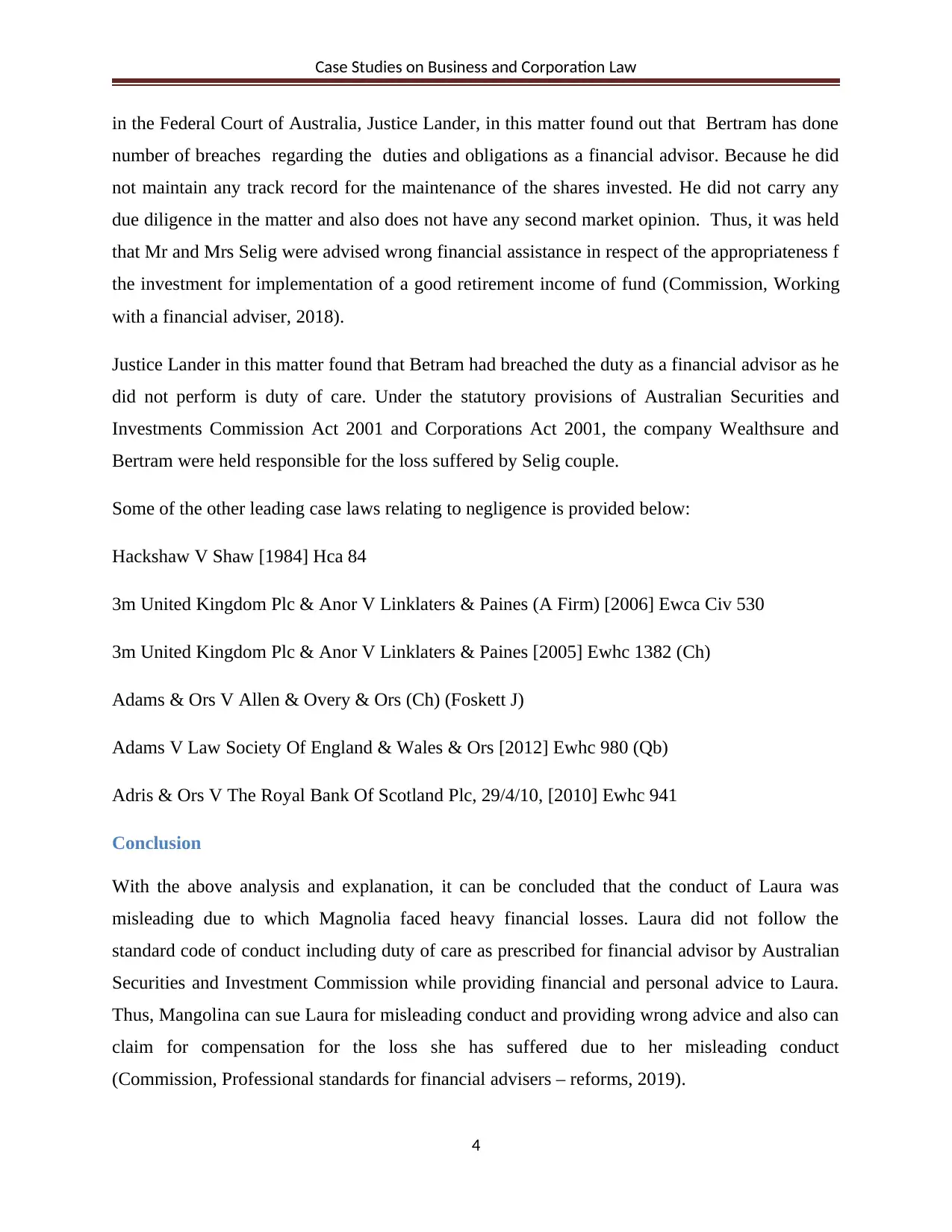
Case Studies on Business and Corporation Law
in the Federal Court of Australia, Justice Lander, in this matter found out that Bertram has done
number of breaches regarding the duties and obligations as a financial advisor. Because he did
not maintain any track record for the maintenance of the shares invested. He did not carry any
due diligence in the matter and also does not have any second market opinion. Thus, it was held
that Mr and Mrs Selig were advised wrong financial assistance in respect of the appropriateness f
the investment for implementation of a good retirement income of fund (Commission, Working
with a financial adviser, 2018).
Justice Lander in this matter found that Betram had breached the duty as a financial advisor as he
did not perform is duty of care. Under the statutory provisions of Australian Securities and
Investments Commission Act 2001 and Corporations Act 2001, the company Wealthsure and
Bertram were held responsible for the loss suffered by Selig couple.
Some of the other leading case laws relating to negligence is provided below:
Hackshaw V Shaw [1984] Hca 84
3m United Kingdom Plc & Anor V Linklaters & Paines (A Firm) [2006] Ewca Civ 530
3m United Kingdom Plc & Anor V Linklaters & Paines [2005] Ewhc 1382 (Ch)
Adams & Ors V Allen & Overy & Ors (Ch) (Foskett J)
Adams V Law Society Of England & Wales & Ors [2012] Ewhc 980 (Qb)
Adris & Ors V The Royal Bank Of Scotland Plc, 29/4/10, [2010] Ewhc 941
Conclusion
With the above analysis and explanation, it can be concluded that the conduct of Laura was
misleading due to which Magnolia faced heavy financial losses. Laura did not follow the
standard code of conduct including duty of care as prescribed for financial advisor by Australian
Securities and Investment Commission while providing financial and personal advice to Laura.
Thus, Mangolina can sue Laura for misleading conduct and providing wrong advice and also can
claim for compensation for the loss she has suffered due to her misleading conduct
(Commission, Professional standards for financial advisers – reforms, 2019).
4
in the Federal Court of Australia, Justice Lander, in this matter found out that Bertram has done
number of breaches regarding the duties and obligations as a financial advisor. Because he did
not maintain any track record for the maintenance of the shares invested. He did not carry any
due diligence in the matter and also does not have any second market opinion. Thus, it was held
that Mr and Mrs Selig were advised wrong financial assistance in respect of the appropriateness f
the investment for implementation of a good retirement income of fund (Commission, Working
with a financial adviser, 2018).
Justice Lander in this matter found that Betram had breached the duty as a financial advisor as he
did not perform is duty of care. Under the statutory provisions of Australian Securities and
Investments Commission Act 2001 and Corporations Act 2001, the company Wealthsure and
Bertram were held responsible for the loss suffered by Selig couple.
Some of the other leading case laws relating to negligence is provided below:
Hackshaw V Shaw [1984] Hca 84
3m United Kingdom Plc & Anor V Linklaters & Paines (A Firm) [2006] Ewca Civ 530
3m United Kingdom Plc & Anor V Linklaters & Paines [2005] Ewhc 1382 (Ch)
Adams & Ors V Allen & Overy & Ors (Ch) (Foskett J)
Adams V Law Society Of England & Wales & Ors [2012] Ewhc 980 (Qb)
Adris & Ors V The Royal Bank Of Scotland Plc, 29/4/10, [2010] Ewhc 941
Conclusion
With the above analysis and explanation, it can be concluded that the conduct of Laura was
misleading due to which Magnolia faced heavy financial losses. Laura did not follow the
standard code of conduct including duty of care as prescribed for financial advisor by Australian
Securities and Investment Commission while providing financial and personal advice to Laura.
Thus, Mangolina can sue Laura for misleading conduct and providing wrong advice and also can
claim for compensation for the loss she has suffered due to her misleading conduct
(Commission, Professional standards for financial advisers – reforms, 2019).
4
Paraphrase This Document
Need a fresh take? Get an instant paraphrase of this document with our AI Paraphraser
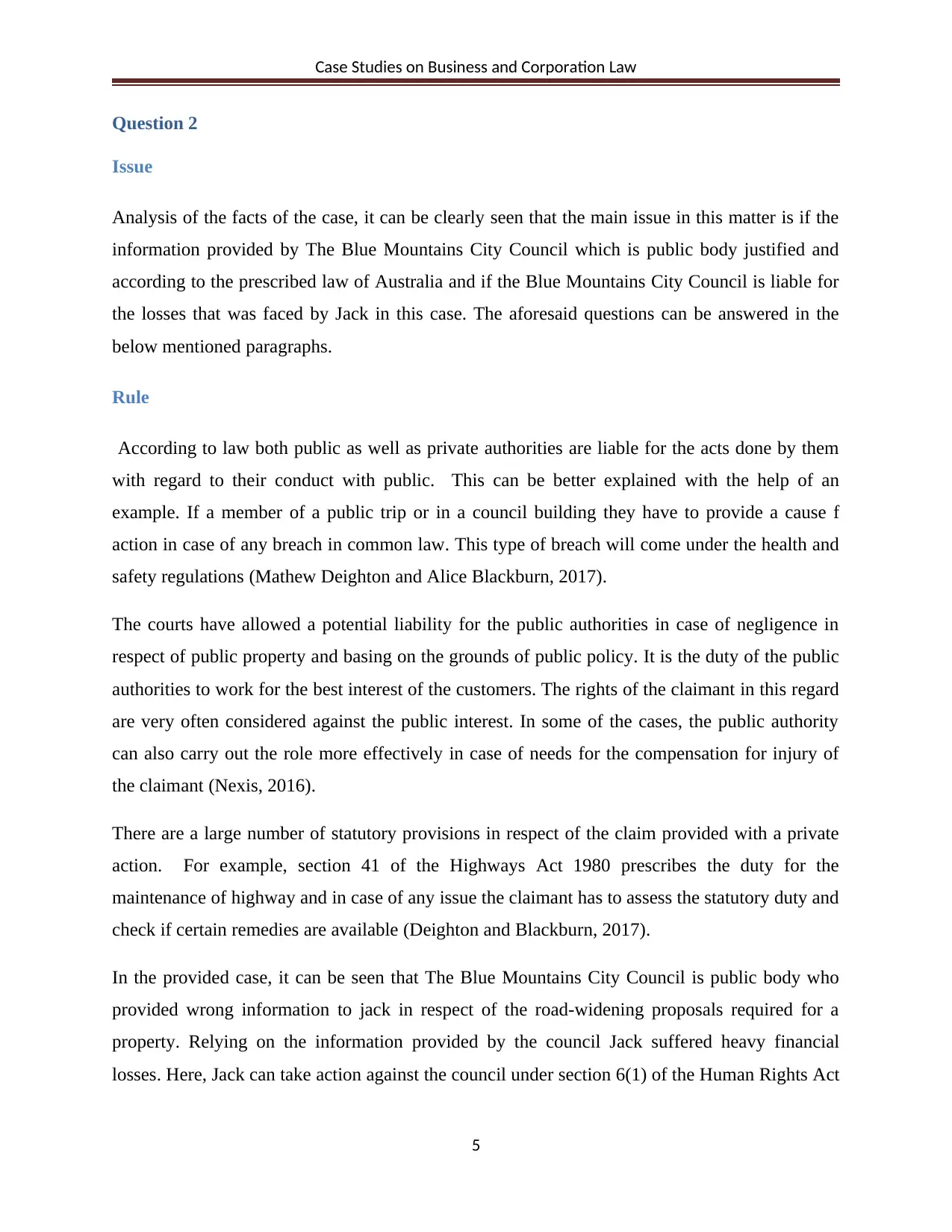
Case Studies on Business and Corporation Law
Question 2
Issue
Analysis of the facts of the case, it can be clearly seen that the main issue in this matter is if the
information provided by The Blue Mountains City Council which is public body justified and
according to the prescribed law of Australia and if the Blue Mountains City Council is liable for
the losses that was faced by Jack in this case. The aforesaid questions can be answered in the
below mentioned paragraphs.
Rule
According to law both public as well as private authorities are liable for the acts done by them
with regard to their conduct with public. This can be better explained with the help of an
example. If a member of a public trip or in a council building they have to provide a cause f
action in case of any breach in common law. This type of breach will come under the health and
safety regulations (Mathew Deighton and Alice Blackburn, 2017).
The courts have allowed a potential liability for the public authorities in case of negligence in
respect of public property and basing on the grounds of public policy. It is the duty of the public
authorities to work for the best interest of the customers. The rights of the claimant in this regard
are very often considered against the public interest. In some of the cases, the public authority
can also carry out the role more effectively in case of needs for the compensation for injury of
the claimant (Nexis, 2016).
There are a large number of statutory provisions in respect of the claim provided with a private
action. For example, section 41 of the Highways Act 1980 prescribes the duty for the
maintenance of highway and in case of any issue the claimant has to assess the statutory duty and
check if certain remedies are available (Deighton and Blackburn, 2017).
In the provided case, it can be seen that The Blue Mountains City Council is public body who
provided wrong information to jack in respect of the road-widening proposals required for a
property. Relying on the information provided by the council Jack suffered heavy financial
losses. Here, Jack can take action against the council under section 6(1) of the Human Rights Act
5
Question 2
Issue
Analysis of the facts of the case, it can be clearly seen that the main issue in this matter is if the
information provided by The Blue Mountains City Council which is public body justified and
according to the prescribed law of Australia and if the Blue Mountains City Council is liable for
the losses that was faced by Jack in this case. The aforesaid questions can be answered in the
below mentioned paragraphs.
Rule
According to law both public as well as private authorities are liable for the acts done by them
with regard to their conduct with public. This can be better explained with the help of an
example. If a member of a public trip or in a council building they have to provide a cause f
action in case of any breach in common law. This type of breach will come under the health and
safety regulations (Mathew Deighton and Alice Blackburn, 2017).
The courts have allowed a potential liability for the public authorities in case of negligence in
respect of public property and basing on the grounds of public policy. It is the duty of the public
authorities to work for the best interest of the customers. The rights of the claimant in this regard
are very often considered against the public interest. In some of the cases, the public authority
can also carry out the role more effectively in case of needs for the compensation for injury of
the claimant (Nexis, 2016).
There are a large number of statutory provisions in respect of the claim provided with a private
action. For example, section 41 of the Highways Act 1980 prescribes the duty for the
maintenance of highway and in case of any issue the claimant has to assess the statutory duty and
check if certain remedies are available (Deighton and Blackburn, 2017).
In the provided case, it can be seen that The Blue Mountains City Council is public body who
provided wrong information to jack in respect of the road-widening proposals required for a
property. Relying on the information provided by the council Jack suffered heavy financial
losses. Here, Jack can take action against the council under section 6(1) of the Human Rights Act
5
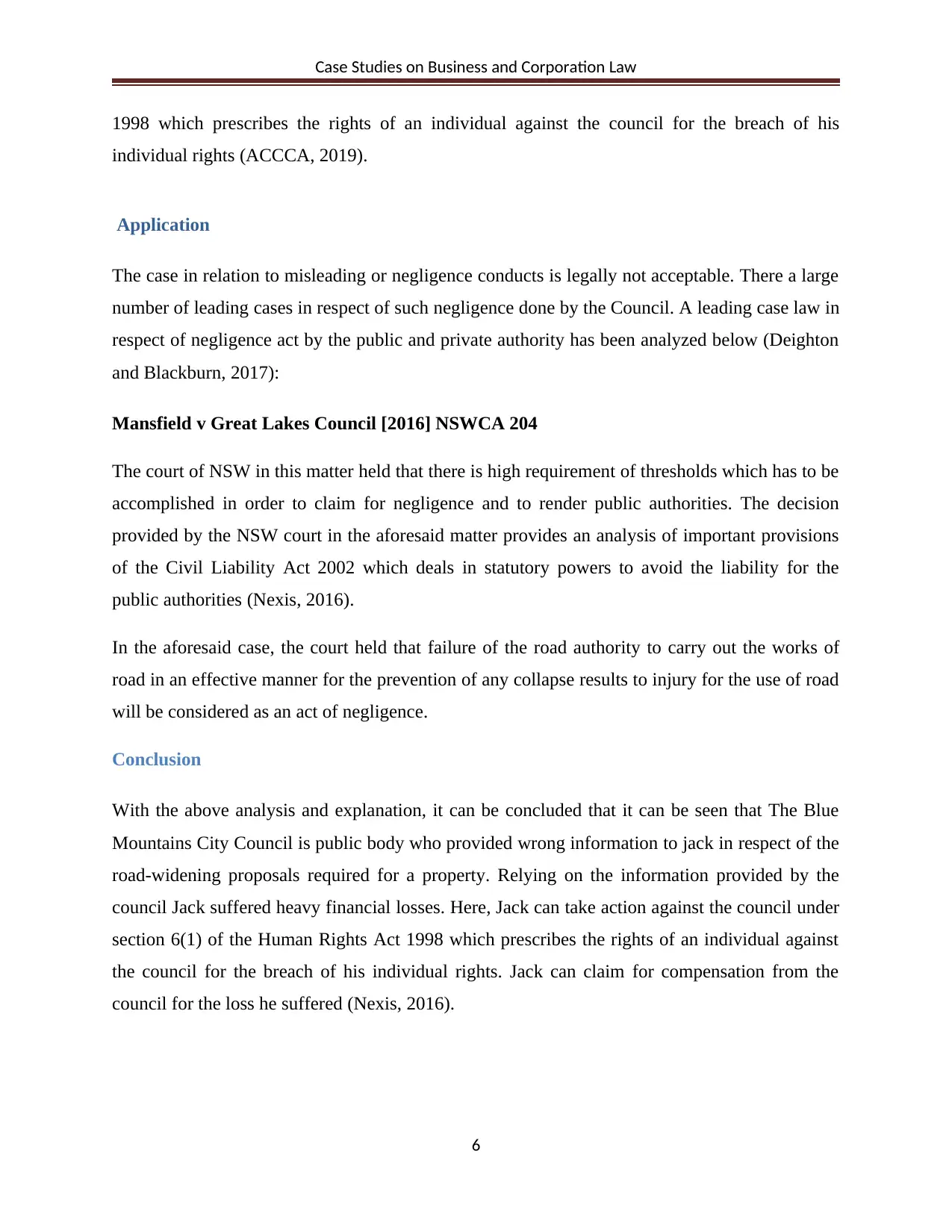
Case Studies on Business and Corporation Law
1998 which prescribes the rights of an individual against the council for the breach of his
individual rights (ACCCA, 2019).
Application
The case in relation to misleading or negligence conducts is legally not acceptable. There a large
number of leading cases in respect of such negligence done by the Council. A leading case law in
respect of negligence act by the public and private authority has been analyzed below (Deighton
and Blackburn, 2017):
Mansfield v Great Lakes Council [2016] NSWCA 204
The court of NSW in this matter held that there is high requirement of thresholds which has to be
accomplished in order to claim for negligence and to render public authorities. The decision
provided by the NSW court in the aforesaid matter provides an analysis of important provisions
of the Civil Liability Act 2002 which deals in statutory powers to avoid the liability for the
public authorities (Nexis, 2016).
In the aforesaid case, the court held that failure of the road authority to carry out the works of
road in an effective manner for the prevention of any collapse results to injury for the use of road
will be considered as an act of negligence.
Conclusion
With the above analysis and explanation, it can be concluded that it can be seen that The Blue
Mountains City Council is public body who provided wrong information to jack in respect of the
road-widening proposals required for a property. Relying on the information provided by the
council Jack suffered heavy financial losses. Here, Jack can take action against the council under
section 6(1) of the Human Rights Act 1998 which prescribes the rights of an individual against
the council for the breach of his individual rights. Jack can claim for compensation from the
council for the loss he suffered (Nexis, 2016).
6
1998 which prescribes the rights of an individual against the council for the breach of his
individual rights (ACCCA, 2019).
Application
The case in relation to misleading or negligence conducts is legally not acceptable. There a large
number of leading cases in respect of such negligence done by the Council. A leading case law in
respect of negligence act by the public and private authority has been analyzed below (Deighton
and Blackburn, 2017):
Mansfield v Great Lakes Council [2016] NSWCA 204
The court of NSW in this matter held that there is high requirement of thresholds which has to be
accomplished in order to claim for negligence and to render public authorities. The decision
provided by the NSW court in the aforesaid matter provides an analysis of important provisions
of the Civil Liability Act 2002 which deals in statutory powers to avoid the liability for the
public authorities (Nexis, 2016).
In the aforesaid case, the court held that failure of the road authority to carry out the works of
road in an effective manner for the prevention of any collapse results to injury for the use of road
will be considered as an act of negligence.
Conclusion
With the above analysis and explanation, it can be concluded that it can be seen that The Blue
Mountains City Council is public body who provided wrong information to jack in respect of the
road-widening proposals required for a property. Relying on the information provided by the
council Jack suffered heavy financial losses. Here, Jack can take action against the council under
section 6(1) of the Human Rights Act 1998 which prescribes the rights of an individual against
the council for the breach of his individual rights. Jack can claim for compensation from the
council for the loss he suffered (Nexis, 2016).
6
⊘ This is a preview!⊘
Do you want full access?
Subscribe today to unlock all pages.

Trusted by 1+ million students worldwide
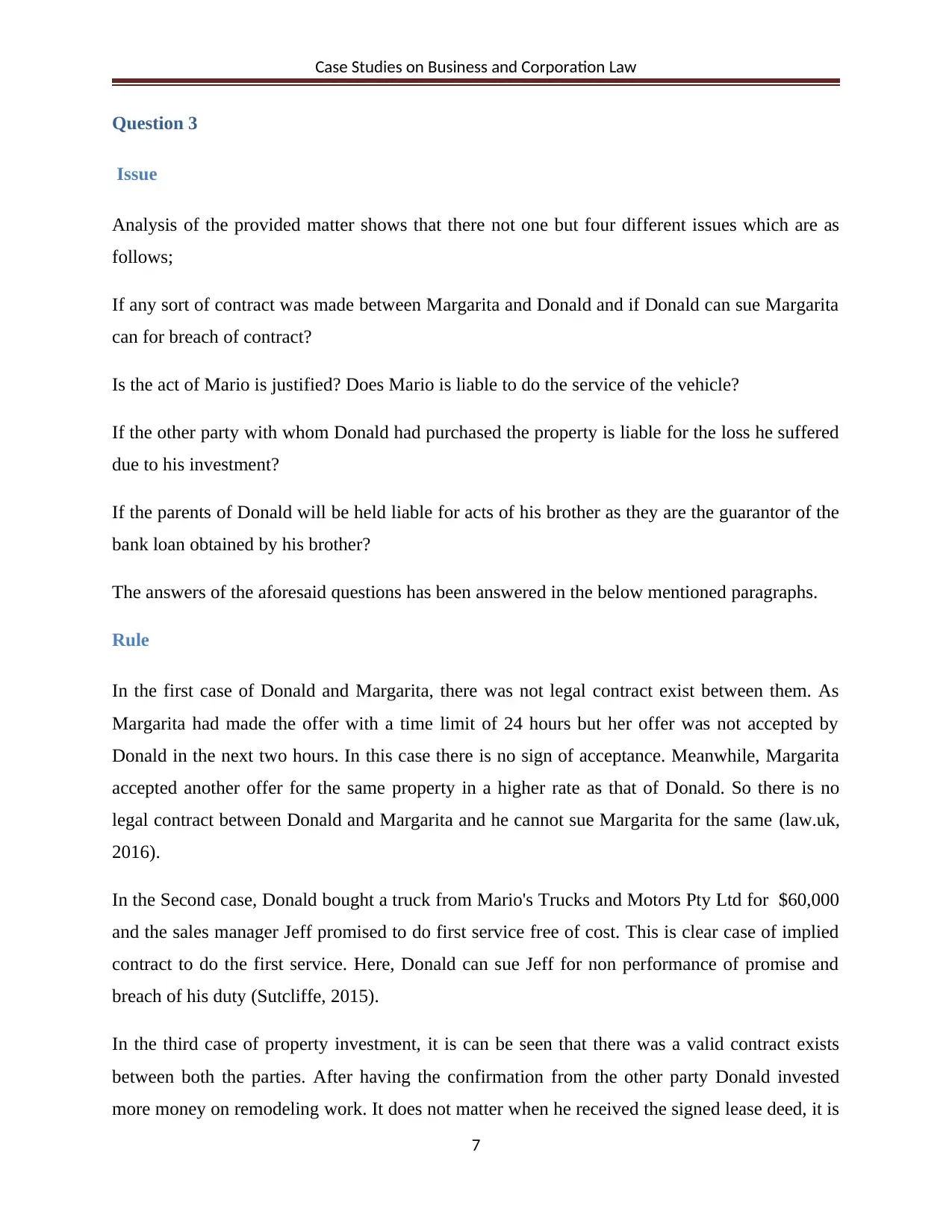
Case Studies on Business and Corporation Law
Question 3
Issue
Analysis of the provided matter shows that there not one but four different issues which are as
follows;
If any sort of contract was made between Margarita and Donald and if Donald can sue Margarita
can for breach of contract?
Is the act of Mario is justified? Does Mario is liable to do the service of the vehicle?
If the other party with whom Donald had purchased the property is liable for the loss he suffered
due to his investment?
If the parents of Donald will be held liable for acts of his brother as they are the guarantor of the
bank loan obtained by his brother?
The answers of the aforesaid questions has been answered in the below mentioned paragraphs.
Rule
In the first case of Donald and Margarita, there was not legal contract exist between them. As
Margarita had made the offer with a time limit of 24 hours but her offer was not accepted by
Donald in the next two hours. In this case there is no sign of acceptance. Meanwhile, Margarita
accepted another offer for the same property in a higher rate as that of Donald. So there is no
legal contract between Donald and Margarita and he cannot sue Margarita for the same (law.uk,
2016).
In the Second case, Donald bought a truck from Mario's Trucks and Motors Pty Ltd for $60,000
and the sales manager Jeff promised to do first service free of cost. This is clear case of implied
contract to do the first service. Here, Donald can sue Jeff for non performance of promise and
breach of his duty (Sutcliffe, 2015).
In the third case of property investment, it is can be seen that there was a valid contract exists
between both the parties. After having the confirmation from the other party Donald invested
more money on remodeling work. It does not matter when he received the signed lease deed, it is
7
Question 3
Issue
Analysis of the provided matter shows that there not one but four different issues which are as
follows;
If any sort of contract was made between Margarita and Donald and if Donald can sue Margarita
can for breach of contract?
Is the act of Mario is justified? Does Mario is liable to do the service of the vehicle?
If the other party with whom Donald had purchased the property is liable for the loss he suffered
due to his investment?
If the parents of Donald will be held liable for acts of his brother as they are the guarantor of the
bank loan obtained by his brother?
The answers of the aforesaid questions has been answered in the below mentioned paragraphs.
Rule
In the first case of Donald and Margarita, there was not legal contract exist between them. As
Margarita had made the offer with a time limit of 24 hours but her offer was not accepted by
Donald in the next two hours. In this case there is no sign of acceptance. Meanwhile, Margarita
accepted another offer for the same property in a higher rate as that of Donald. So there is no
legal contract between Donald and Margarita and he cannot sue Margarita for the same (law.uk,
2016).
In the Second case, Donald bought a truck from Mario's Trucks and Motors Pty Ltd for $60,000
and the sales manager Jeff promised to do first service free of cost. This is clear case of implied
contract to do the first service. Here, Donald can sue Jeff for non performance of promise and
breach of his duty (Sutcliffe, 2015).
In the third case of property investment, it is can be seen that there was a valid contract exists
between both the parties. After having the confirmation from the other party Donald invested
more money on remodeling work. It does not matter when he received the signed lease deed, it is
7
Paraphrase This Document
Need a fresh take? Get an instant paraphrase of this document with our AI Paraphraser
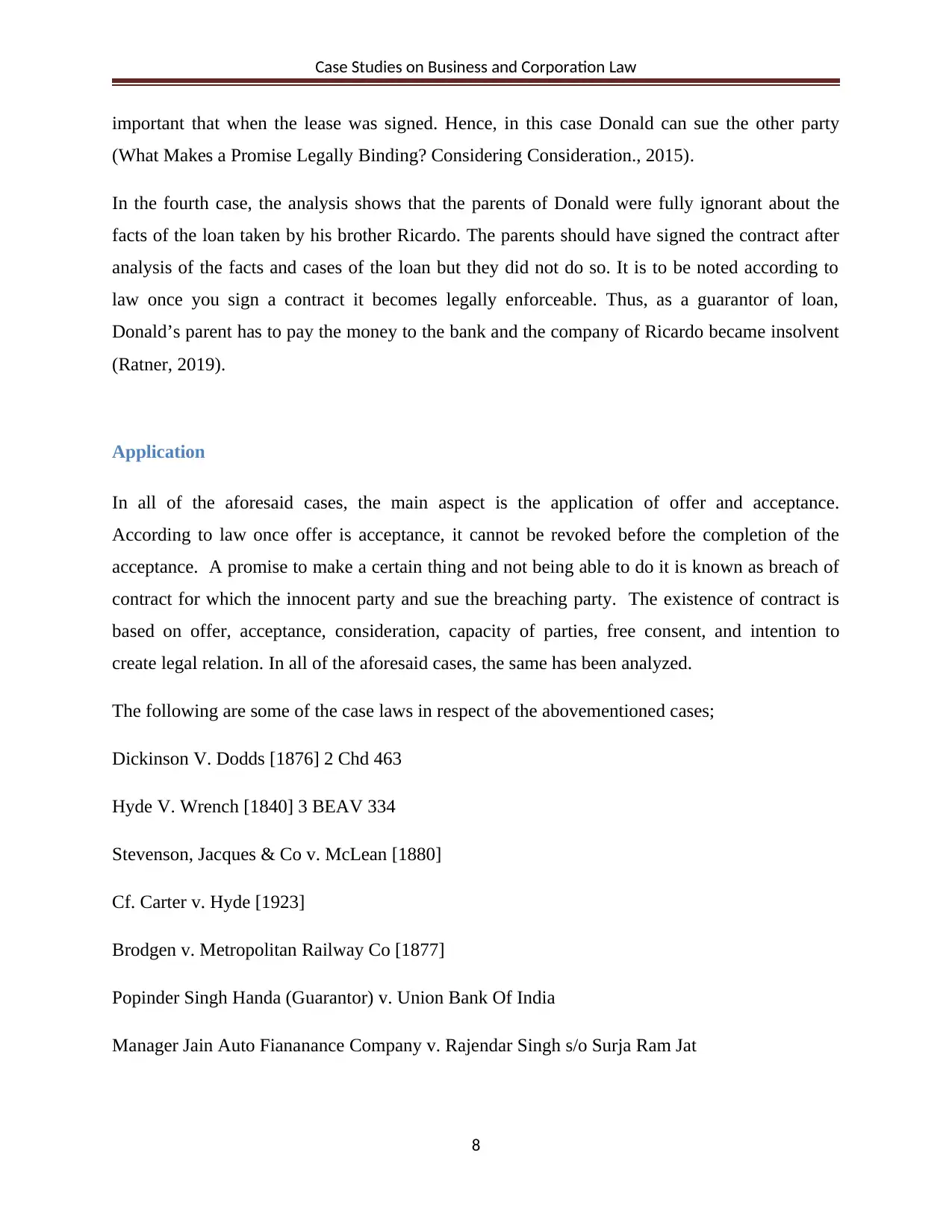
Case Studies on Business and Corporation Law
important that when the lease was signed. Hence, in this case Donald can sue the other party
(What Makes a Promise Legally Binding? Considering Consideration., 2015).
In the fourth case, the analysis shows that the parents of Donald were fully ignorant about the
facts of the loan taken by his brother Ricardo. The parents should have signed the contract after
analysis of the facts and cases of the loan but they did not do so. It is to be noted according to
law once you sign a contract it becomes legally enforceable. Thus, as a guarantor of loan,
Donald’s parent has to pay the money to the bank and the company of Ricardo became insolvent
(Ratner, 2019).
Application
In all of the aforesaid cases, the main aspect is the application of offer and acceptance.
According to law once offer is acceptance, it cannot be revoked before the completion of the
acceptance. A promise to make a certain thing and not being able to do it is known as breach of
contract for which the innocent party and sue the breaching party. The existence of contract is
based on offer, acceptance, consideration, capacity of parties, free consent, and intention to
create legal relation. In all of the aforesaid cases, the same has been analyzed.
The following are some of the case laws in respect of the abovementioned cases;
Dickinson V. Dodds [1876] 2 Chd 463
Hyde V. Wrench [1840] 3 BEAV 334
Stevenson, Jacques & Co v. McLean [1880]
Cf. Carter v. Hyde [1923]
Brodgen v. Metropolitan Railway Co [1877]
Popinder Singh Handa (Guarantor) v. Union Bank Of India
Manager Jain Auto Fiananance Company v. Rajendar Singh s/o Surja Ram Jat
8
important that when the lease was signed. Hence, in this case Donald can sue the other party
(What Makes a Promise Legally Binding? Considering Consideration., 2015).
In the fourth case, the analysis shows that the parents of Donald were fully ignorant about the
facts of the loan taken by his brother Ricardo. The parents should have signed the contract after
analysis of the facts and cases of the loan but they did not do so. It is to be noted according to
law once you sign a contract it becomes legally enforceable. Thus, as a guarantor of loan,
Donald’s parent has to pay the money to the bank and the company of Ricardo became insolvent
(Ratner, 2019).
Application
In all of the aforesaid cases, the main aspect is the application of offer and acceptance.
According to law once offer is acceptance, it cannot be revoked before the completion of the
acceptance. A promise to make a certain thing and not being able to do it is known as breach of
contract for which the innocent party and sue the breaching party. The existence of contract is
based on offer, acceptance, consideration, capacity of parties, free consent, and intention to
create legal relation. In all of the aforesaid cases, the same has been analyzed.
The following are some of the case laws in respect of the abovementioned cases;
Dickinson V. Dodds [1876] 2 Chd 463
Hyde V. Wrench [1840] 3 BEAV 334
Stevenson, Jacques & Co v. McLean [1880]
Cf. Carter v. Hyde [1923]
Brodgen v. Metropolitan Railway Co [1877]
Popinder Singh Handa (Guarantor) v. Union Bank Of India
Manager Jain Auto Fiananance Company v. Rajendar Singh s/o Surja Ram Jat
8
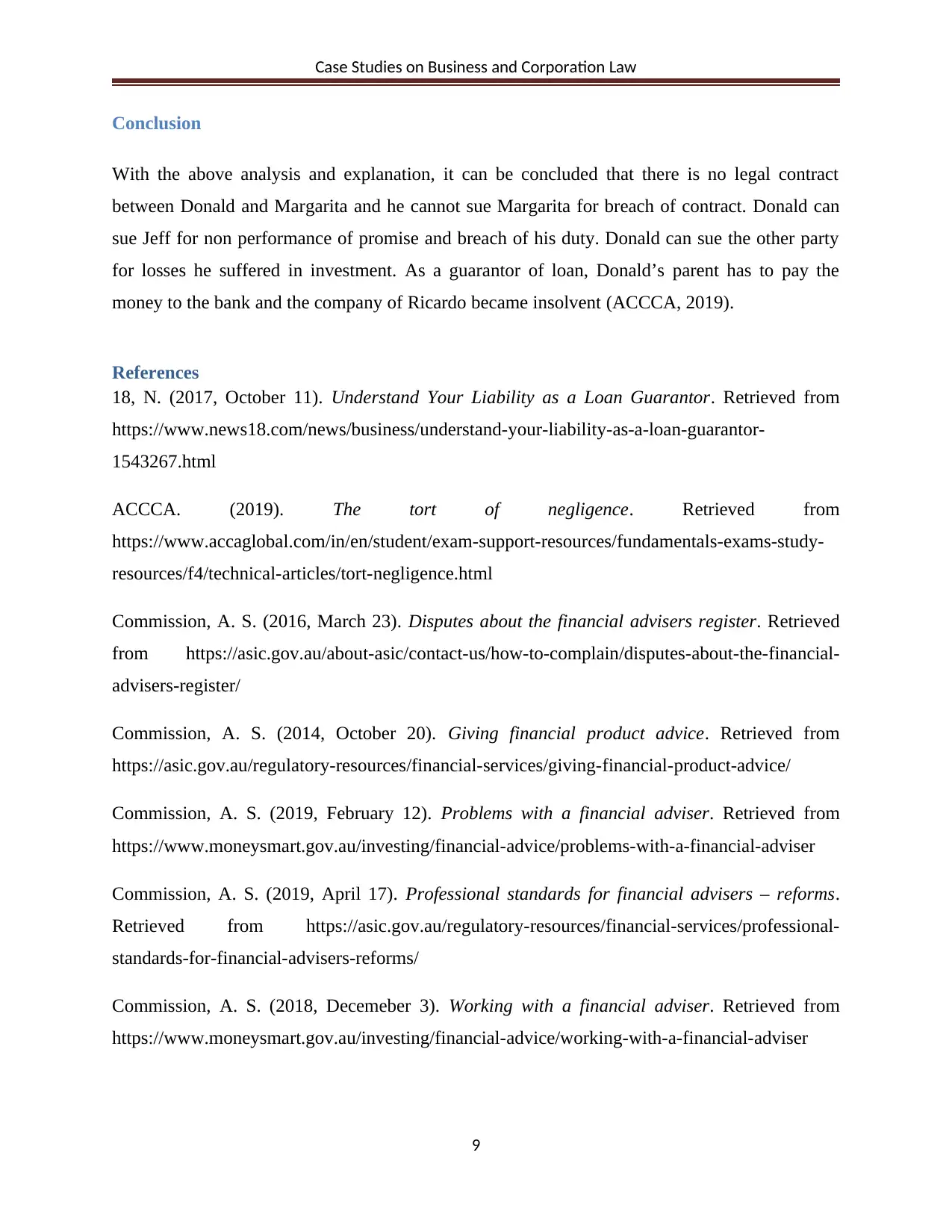
Case Studies on Business and Corporation Law
Conclusion
With the above analysis and explanation, it can be concluded that there is no legal contract
between Donald and Margarita and he cannot sue Margarita for breach of contract. Donald can
sue Jeff for non performance of promise and breach of his duty. Donald can sue the other party
for losses he suffered in investment. As a guarantor of loan, Donald’s parent has to pay the
money to the bank and the company of Ricardo became insolvent (ACCCA, 2019).
References
18, N. (2017, October 11). Understand Your Liability as a Loan Guarantor. Retrieved from
https://www.news18.com/news/business/understand-your-liability-as-a-loan-guarantor-
1543267.html
ACCCA. (2019). The tort of negligence. Retrieved from
https://www.accaglobal.com/in/en/student/exam-support-resources/fundamentals-exams-study-
resources/f4/technical-articles/tort-negligence.html
Commission, A. S. (2016, March 23). Disputes about the financial advisers register. Retrieved
from https://asic.gov.au/about-asic/contact-us/how-to-complain/disputes-about-the-financial-
advisers-register/
Commission, A. S. (2014, October 20). Giving financial product advice. Retrieved from
https://asic.gov.au/regulatory-resources/financial-services/giving-financial-product-advice/
Commission, A. S. (2019, February 12). Problems with a financial adviser. Retrieved from
https://www.moneysmart.gov.au/investing/financial-advice/problems-with-a-financial-adviser
Commission, A. S. (2019, April 17). Professional standards for financial advisers – reforms.
Retrieved from https://asic.gov.au/regulatory-resources/financial-services/professional-
standards-for-financial-advisers-reforms/
Commission, A. S. (2018, Decemeber 3). Working with a financial adviser. Retrieved from
https://www.moneysmart.gov.au/investing/financial-advice/working-with-a-financial-adviser
9
Conclusion
With the above analysis and explanation, it can be concluded that there is no legal contract
between Donald and Margarita and he cannot sue Margarita for breach of contract. Donald can
sue Jeff for non performance of promise and breach of his duty. Donald can sue the other party
for losses he suffered in investment. As a guarantor of loan, Donald’s parent has to pay the
money to the bank and the company of Ricardo became insolvent (ACCCA, 2019).
References
18, N. (2017, October 11). Understand Your Liability as a Loan Guarantor. Retrieved from
https://www.news18.com/news/business/understand-your-liability-as-a-loan-guarantor-
1543267.html
ACCCA. (2019). The tort of negligence. Retrieved from
https://www.accaglobal.com/in/en/student/exam-support-resources/fundamentals-exams-study-
resources/f4/technical-articles/tort-negligence.html
Commission, A. S. (2016, March 23). Disputes about the financial advisers register. Retrieved
from https://asic.gov.au/about-asic/contact-us/how-to-complain/disputes-about-the-financial-
advisers-register/
Commission, A. S. (2014, October 20). Giving financial product advice. Retrieved from
https://asic.gov.au/regulatory-resources/financial-services/giving-financial-product-advice/
Commission, A. S. (2019, February 12). Problems with a financial adviser. Retrieved from
https://www.moneysmart.gov.au/investing/financial-advice/problems-with-a-financial-adviser
Commission, A. S. (2019, April 17). Professional standards for financial advisers – reforms.
Retrieved from https://asic.gov.au/regulatory-resources/financial-services/professional-
standards-for-financial-advisers-reforms/
Commission, A. S. (2018, Decemeber 3). Working with a financial adviser. Retrieved from
https://www.moneysmart.gov.au/investing/financial-advice/working-with-a-financial-adviser
9
⊘ This is a preview!⊘
Do you want full access?
Subscribe today to unlock all pages.

Trusted by 1+ million students worldwide
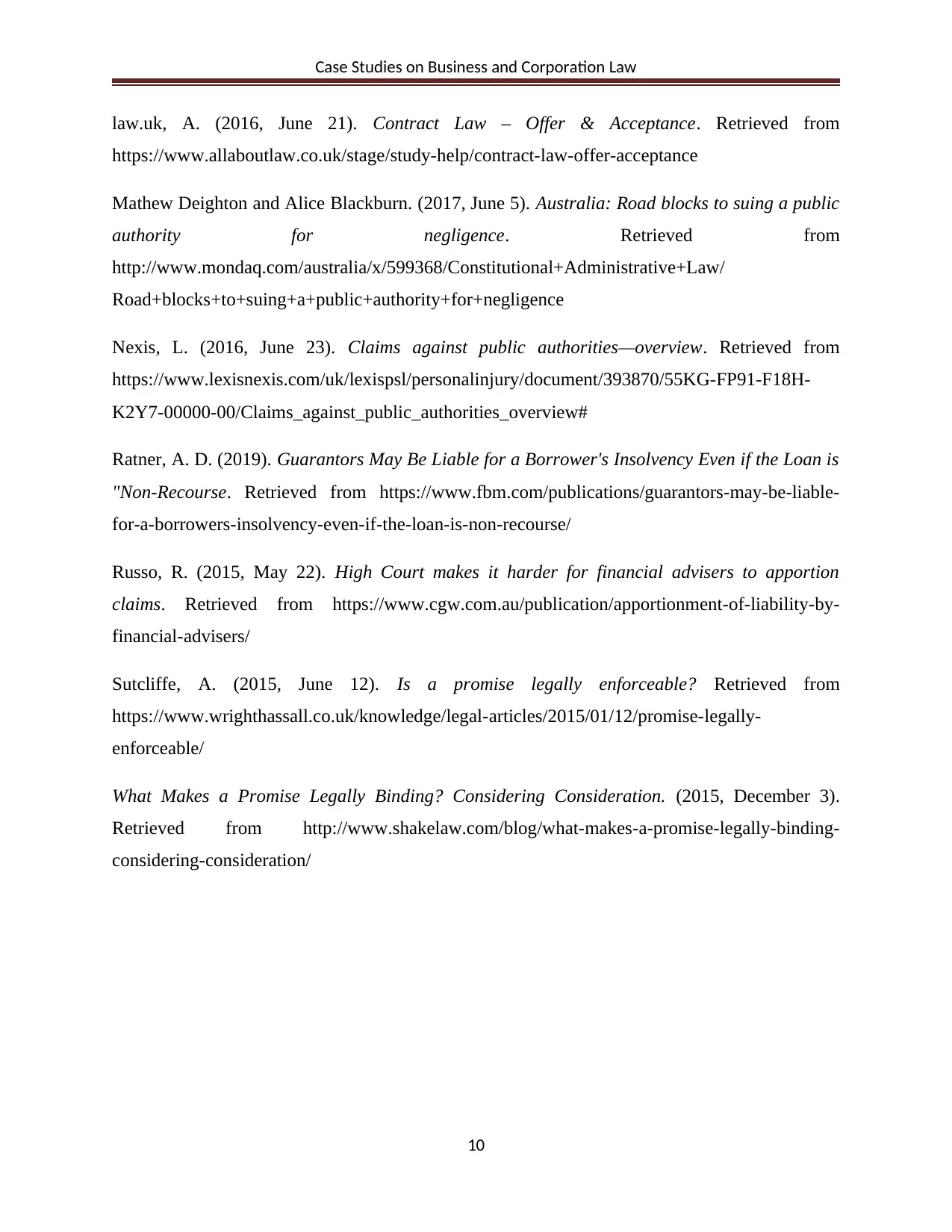
Case Studies on Business and Corporation Law
law.uk, A. (2016, June 21). Contract Law – Offer & Acceptance. Retrieved from
https://www.allaboutlaw.co.uk/stage/study-help/contract-law-offer-acceptance
Mathew Deighton and Alice Blackburn. (2017, June 5). Australia: Road blocks to suing a public
authority for negligence. Retrieved from
http://www.mondaq.com/australia/x/599368/Constitutional+Administrative+Law/
Road+blocks+to+suing+a+public+authority+for+negligence
Nexis, L. (2016, June 23). Claims against public authorities—overview. Retrieved from
https://www.lexisnexis.com/uk/lexispsl/personalinjury/document/393870/55KG-FP91-F18H-
K2Y7-00000-00/Claims_against_public_authorities_overview#
Ratner, A. D. (2019). Guarantors May Be Liable for a Borrower's Insolvency Even if the Loan is
"Non-Recourse. Retrieved from https://www.fbm.com/publications/guarantors-may-be-liable-
for-a-borrowers-insolvency-even-if-the-loan-is-non-recourse/
Russo, R. (2015, May 22). High Court makes it harder for financial advisers to apportion
claims. Retrieved from https://www.cgw.com.au/publication/apportionment-of-liability-by-
financial-advisers/
Sutcliffe, A. (2015, June 12). Is a promise legally enforceable? Retrieved from
https://www.wrighthassall.co.uk/knowledge/legal-articles/2015/01/12/promise-legally-
enforceable/
What Makes a Promise Legally Binding? Considering Consideration. (2015, December 3).
Retrieved from http://www.shakelaw.com/blog/what-makes-a-promise-legally-binding-
considering-consideration/
10
law.uk, A. (2016, June 21). Contract Law – Offer & Acceptance. Retrieved from
https://www.allaboutlaw.co.uk/stage/study-help/contract-law-offer-acceptance
Mathew Deighton and Alice Blackburn. (2017, June 5). Australia: Road blocks to suing a public
authority for negligence. Retrieved from
http://www.mondaq.com/australia/x/599368/Constitutional+Administrative+Law/
Road+blocks+to+suing+a+public+authority+for+negligence
Nexis, L. (2016, June 23). Claims against public authorities—overview. Retrieved from
https://www.lexisnexis.com/uk/lexispsl/personalinjury/document/393870/55KG-FP91-F18H-
K2Y7-00000-00/Claims_against_public_authorities_overview#
Ratner, A. D. (2019). Guarantors May Be Liable for a Borrower's Insolvency Even if the Loan is
"Non-Recourse. Retrieved from https://www.fbm.com/publications/guarantors-may-be-liable-
for-a-borrowers-insolvency-even-if-the-loan-is-non-recourse/
Russo, R. (2015, May 22). High Court makes it harder for financial advisers to apportion
claims. Retrieved from https://www.cgw.com.au/publication/apportionment-of-liability-by-
financial-advisers/
Sutcliffe, A. (2015, June 12). Is a promise legally enforceable? Retrieved from
https://www.wrighthassall.co.uk/knowledge/legal-articles/2015/01/12/promise-legally-
enforceable/
What Makes a Promise Legally Binding? Considering Consideration. (2015, December 3).
Retrieved from http://www.shakelaw.com/blog/what-makes-a-promise-legally-binding-
considering-consideration/
10
1 out of 10
Related Documents
Your All-in-One AI-Powered Toolkit for Academic Success.
+13062052269
info@desklib.com
Available 24*7 on WhatsApp / Email
![[object Object]](/_next/static/media/star-bottom.7253800d.svg)
Unlock your academic potential
Copyright © 2020–2025 A2Z Services. All Rights Reserved. Developed and managed by ZUCOL.



![Detailed Case Study: ASIC v Narain [2008] FCAFC 120 - Corporations Law](/_next/image/?url=https%3A%2F%2Fdesklib.com%2Fmedia%2Fimages%2Fjp%2Fef194f4833aa4344888c1630d12f41be.jpg&w=256&q=75)

